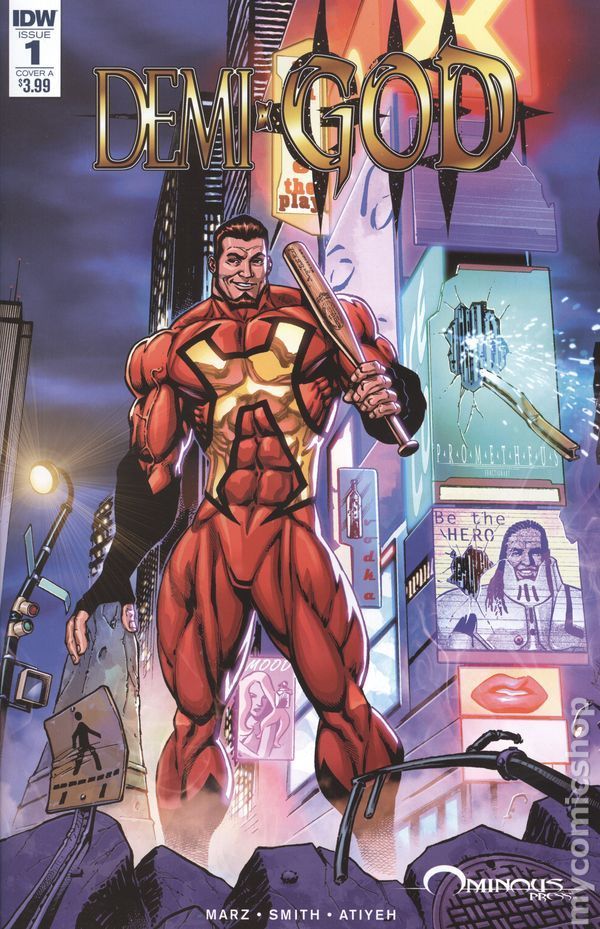
Not too long ago John Jackson Miller, statistical vizier of Comichron, tweeted his findings on a study of 20 years of comic book sales:
Strong counterpoint to those who promote "death of the floppy" narratives: periodical sales over time have been remarkably stable. April sales for the Top 300 comics this year — and 1, 5, 10, 15, and 20 years ago — are all in a narrow million-copy range. https://t.co/7RSwSMFJqw pic.twitter.com/NZHroNKtPc
— Comichron.com (@comichron) May 7, 2018
Which shows that either
• Periodical sales have been remarkably stable for 20 years!
or
• Periodical sales are flat despite 20 years of exploding interest in all things comics.
Both things are sort of true. It is indeed remarkable that in a time when magazines and newspapers have died, the format of a 32 page stapled pamphlet containing a variable amount of story remains viable and desirable.
Sktchd’s David Harper, who also likes to fiddle with charts, took it upon himself to do a deep dive into periodical sales and came up with rolling weighted averages and sales above average, but also noted the durability of the format:
Think about it like this: typically in forms of entertainment, you see older formats decrease in viability as new ones are introduced. After all, we’re not living in an era where people watch movies via streaming, blu rays, laser discs and Betamax. And in recent years, the book market for comics has exploded, while the digital marketplace has matured. We don’t just have ComiXology, but other vendors like Marvel Unlimited, Hoopla, ComicBlitz and beyond. Webcomics have increased in viability as well, especially when you factor in the ability to combine them with crowd-funding services like Kickstarter or Patreon, which give creators the option of actually making money off them (fancy that!). Comics are everywhere, and there are more ways than ever to buy and read them.
Yet, with all that expansion, the total orders in Diamond’s Top 300 has stayed relatively static over the past 20 years.
On the surface, that’s an enormously important thing. It runs contrary to how every other medium has behaved, and shows comics as an ecosystem that seemingly can support a wide array of formats at the same time. If the core element is flat while everything else grows, that’s astonishing and atypical, and a very healthy thing indeed.
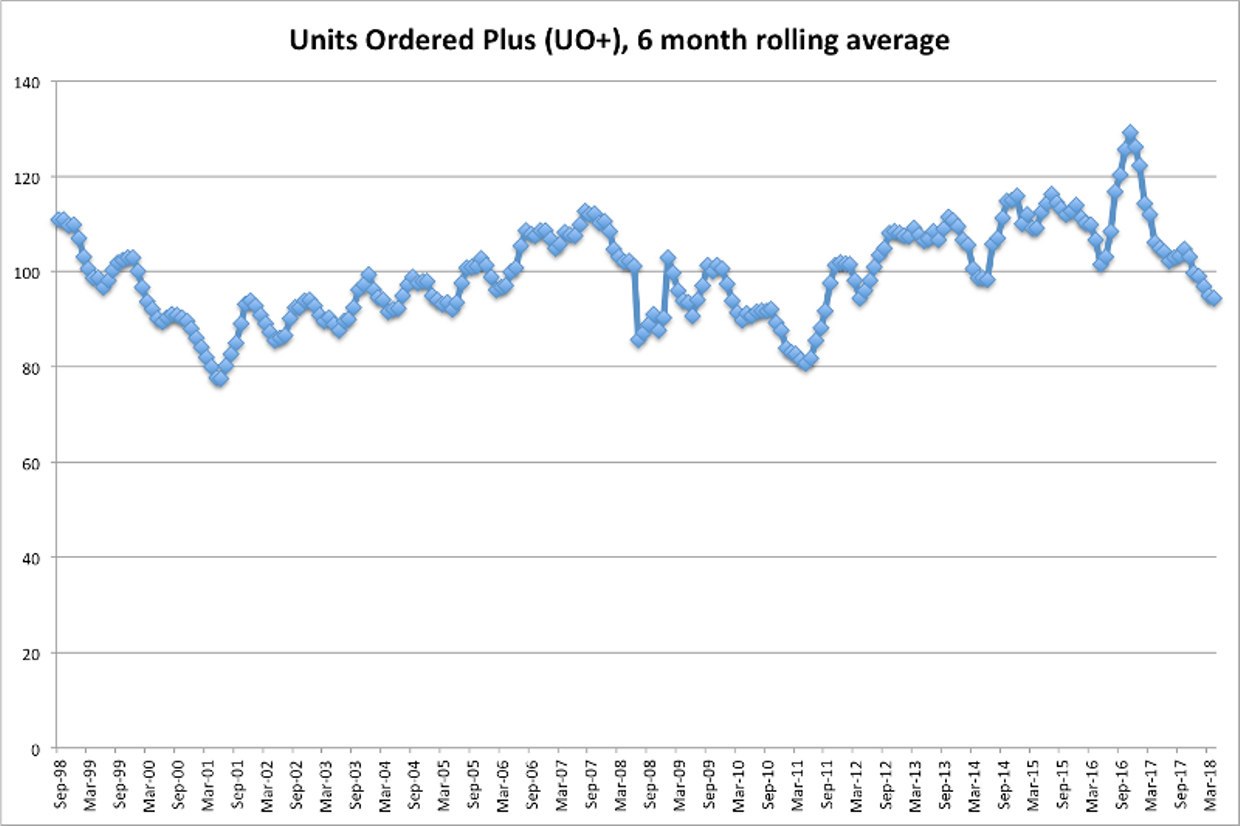
Oh okay I will show one more chart because this is the best one:
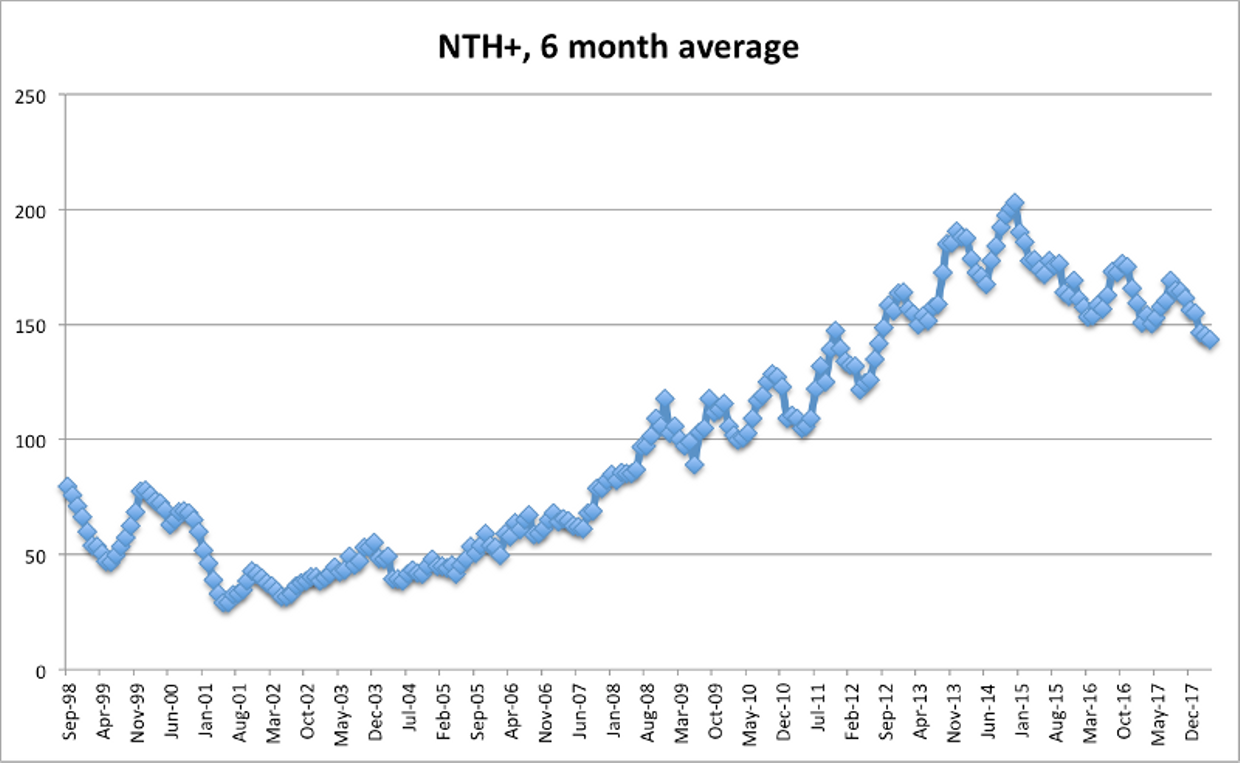
All that said, it’s still a relatively low number. In April 2018 it was 3,854 for IDW’s Demi-God, a book about a man with very muscular thighs which I…never heard of. It’s from Ominous Press, which is Bart Sears’ little mini universe, which IDW is publishing after a Kickstarter.
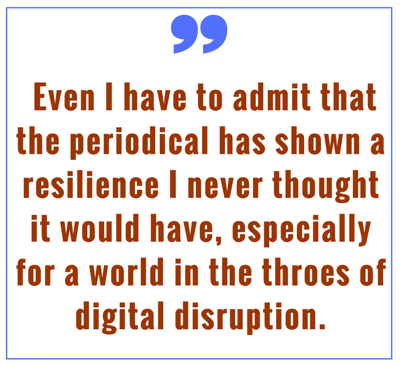
John Jackson Miller is definitely a pamphlet-friendly pundit, and I’m not anti pamphlet, but I do think the comics industry is way better off having a variety of formats, and the explosion of graphic novel sales shows that.
Still, even I have to admit that the periodical has shown a resilience I never thought it would have, especially for a world in the throes of digital disruption.
To what do we owe that resilience? Well, part of it is that Marvel and DC are just super super super dedicated to keeping the format alive. Part of this is because the “scam” of selling periodicals on a non-returnable basis is utterly irresistible! Other industries have returns all the time, but not comic books! I suspect that there is some psychological effect at play with comics retailers, as well, who are honor bound to sell these things since they can’t get rid of them. Over the 40 years that the Direct Market has existed, it’s developed into a super cozy eco-system of co-dependency.
But we increasingly see DC, at least, breaking away from that a bit, with their new standalone catalog, and three new graphic novel lines. This is a little surprising since Dan DiDio is also a confirmed pamphlet man, but eventually you gotta read the handwriting on the wall: the industry supports multiple formats now and you’d be foolish not to sell in all of them.
Still, the stagnancy of periodical sales remains troubling. Is there NO WAY to get the crowds streaming out of movie theaters to pick up a comic book and say “I want to keep reading this?” Maybe it’s naive in this time to think that any spin-off product will satisfy customers of the cineplex, still the most spectacular media experience available to the average person. But only The Walking Dead seems to have capitalized on the TV crossover potential, mostly by having the same guy make both products. (Will the MIllarverse do the same?) Marvel and DC have both shunned direct tie-ins – remember how DC had to be shamed into putting out a Supergirl comic when the TV show debuted? — a policy no doubt earned from crappy sales over the years.
But why are the comics so much less compelling than other media? Perhaps it’s that….they are just not that compelling. No names, but I have a hard time reading most “mainstream” comics, even as someone trained in the vernacular.
The other thing is something that kept coming up at TCAF. How does a medium that has traditionally been aimed at youth culture adapt when it’s mostly written by middle aged white guys? I know Marvel is trying to promote a youth (or “Young Gun”) movement, but Bendis is bringing his veteran brigade with him to DC, not all of them MAWG, but it’s about as kid friendly as a bright red sports car purchased to relive bygone eras, only with panels.
Anyway, the comics pamphlet is probably here to stay, even if it is mostly a nostalgia item. But to say that it has real growth potential…that is not as clear and I just don’t know why.


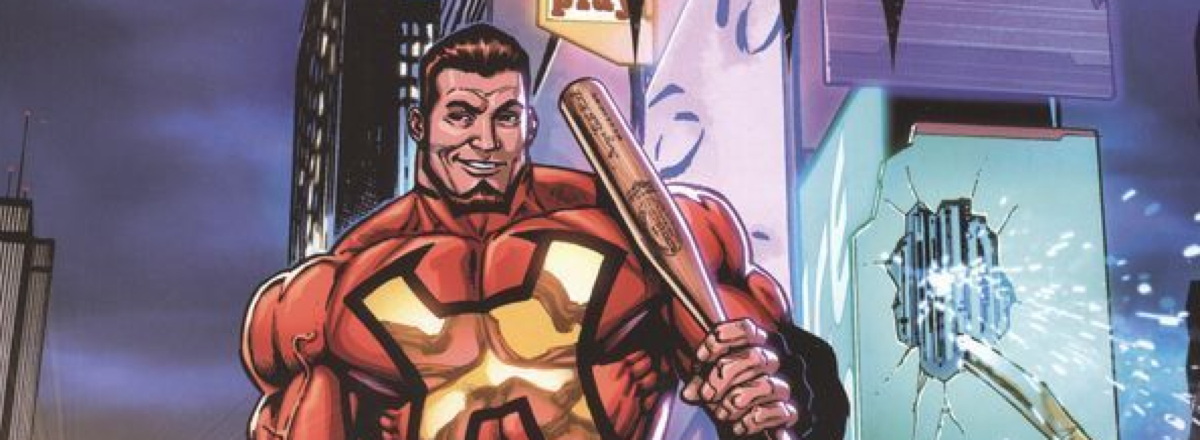
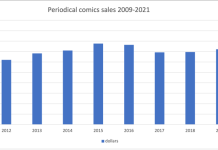




Another element to take into account is the evolution of the US population over this 20-year span. According to the US Census, the population in 1997 was 272.6 million, vs 325.7 million for 2017, or a progression of +19.5%. Which means that, basically, the pamphlet has lost ground among consumers.
“It is indeed remarkable that in a time when magazines and newspapers have died, the format of a 32 page stapled pamphlet containing a variable amount of story remains viable and desirable.”
Viable and desirable for an inbred fanboy/collector audience that has not grown in 20 years.
“Anyway, the comics pamphlet is probably here to stay, even if it is mostly a nostalgia item.”
Yes, the comic book has joined jazz and blues records as once-popular forms that are now kept alive by an aging audience of collectors — as Robert Crumb could tell you.
” Is there NO WAY to get the crowds streaming out of movie theaters to pick up a comic book and say “I want to keep reading this?”
Maybe if floppies were sold physically through Amazon/not sold in specialty shops you have to hunt down and find. You have to want to find floppy comics, it’s not something you’d find in like a Target. I see “where do I start” styled posts on r/comicbooks and r/dcccomics everyday, there is an interest but I never tell them to go buy floppies. It’s always just go pick up some collections because they’re cheaper and a better way to onboard someone than say hunt down these 40 back issues. I’d be curious to see what the graphs look like for monthly bookscan/Diamond numbers compared to the direct market.
DC bought TV ads (and movie screen ads) for their New Age of Heroes stuff but all they said was: new superheroes are coming they didn’t include a location or Amazon logo on where to buy them.
It’s hilarious that when presented with plain facts of audience retention that virtually any other medium or industry would kill to have nowadays, the first two comments put a negative spin on them.
As for why comics are unable to branch out beyond the subculture currently buying them?
1. Price.
2. The modern style of comic storytelling in the Direct Market is aesthetically garbage. It’s marginally improved from the depth of decompression but most of these things aren’t really comic books any more. They are picture books for adults that anyone with a grade school education can read in less than five minutes. When collected into trades, the style is slightly more palatable but still provides poor “bang for the buck” when compared to other media. As serialized entertainment, however, it stinks on ice.
Mike
One reason I think the format punches better than its weight is that the comic book is more than just a way-station there to help create, advertise, and amortize the eventual trade paperback. It’s integral and essential to the aftermarket industry. Publishers sell 90 million-plus new comics annually for around $400 million — but then perhaps half that much is added annually from the likely 20 billion-plus comics that are already out there.
It got easy to forget about or ignore the aftermarket when back issue boxes moved off the main floor, to be replaced by graphic novel shelves — but it’s still a very active business online and at the right kind of cons. (And then there’s the knock-on dollars-and-cents effect to the convention trade, itself, which has certainly expanded over the years.)
As to expecting the size of the readership to track population growth, I’m hard-pressed to think of many audiences for anything — or participation bases for leisure sports or hobbies — that have succeeded at that in this multi-choice age. I think the question is more, are we selling enough new copies of periodicals monthly to support an industry that has, in most years, grown — and the answer for the last two decades has been “so far, evidently so.”
“How does a medium that has traditionally been aimed at youth culture adapt when it’s mostly written by middle aged white guys?”
I think of that when I look at the current “hip” Archie line, which is stuck in the ’90s in terms of fashion and attitude. As I’ve mentioned before, Buffy the Vampire Slayer — a TV show that premiered 21 years ago — is the obvious template for these comics.
But this isn’t a new problem. Remember Marv Wolfman’s Nova, which had ’70s teens hanging out in a malt shop right out of “Happy Days”? And there were DC’s attempts to look “with it” in the ’60s, with 50-ish writers using words like “boss” and “gear” and “grotty.” (Exhibit A: Bob Haney’s Teen Titans.)
“Is there NO WAY to get the crowds streaming out of movie theaters to pick up a comic book and say “I want to keep reading this?” ”
Maybe people have read about “fans” sending death and rape threats to movie critics for panning superhero movies — which is not an urban legend; it really happens — and don’t want to be part of that particular subculture. And there’s the fact that a lot of comic shops are not welcoming places for newcomers, or for women and kids. The surly young male clerks behind the counter ensure that.
George, you level unfounded generalizations at comic shops. I’ve been to several comic shops in the last few years, and I wouldn’t say any of them were not welcoming to women or children. The one I go to regularly has ladies stop in while I’m there, and kids sometimes run in unattended to get their few dollar bin books or the latest new issue of their favorite book. (And it’s your traditional type of comics “cave”) The comics industry as a whole seems to be making strides in providing content and experiences more suitable to everyone these days. Don’t trash the industry based on an outdated stereotype.
I don’t suppose you’ve been tracking the # of SKUs reports? I doubt those go back 20 years, either…. Its not unusual for individual comics today to have more covers than I have fingers.
-B
I think one area where these discussions tend to break down is over what would actually constitute success for comics.
I see that publishers have been selling enough periodicals to keep the overall print business going, and fuel both a convention and a TV/movie slate that probably couldn’t be any larger — and I think, yeah, I’d love to see a thousand more comics shops and healthier mass-market bookstores, but beyond that I don’t know what’s realistic to hope for. Others’ wish-lists have more to do with what’s in the comics, who’s publishing them, and who’s buying them — and they arrive at different definitions of success and a different judgment of periodicals’ contribution toward that. That’s fine — I just don’t know that there’s a consensus view to be had.
I was thinking earlier of Don Thompson, who passed away 24 years ago today: He wrote a column once with Maggie when the comics bubble-market was near the peak, where if I recall correctly, he suggested that every hobby gets a “moment” now and again when the general public is suddenly reminded of its existence. His advice was to avoid thinking “Fellow stamp collectors, our time is now!” because it never lasts, and the more important thing was for comics to focus on what would keep it going in the years when it wasn’t having its “moment.” Maybe that’s why I call a straight line stable rather than flat: when keeping going is key, tie goes to the runner.
Brian, the number of SKUs has definitely proliferated — and the fact that the lower-ranked comics are selling better means retailers have to care about more titles than ever. And that of course takes time, money, and rack space — full agreement there.
I do think a certain level of customization was inevitable as technology made it possible to print more different covers more cheaply; the trick is keeping the options being offered manageable and affordable, and that starts with the publishers.
Nick, that “outdated stereotype” still exists in many places. We’re not living in a Utopia.
I’ve been to comic shops in recent years that are wonderful, and others that are dudebro hangouts that might as well have a NO GIRLZ ALLOWED sign on the front door.
Hey Brian! I talk about the volume of titles/SKUs in my write-up. It’s impossible to ignore in context of this conversation, and I’ve written about it several times (and talked to you about it on the podcast). It’s not brought up in Heidi’s piece, but it certainly comes up in mine when those charts are talked about.
Great points in the article and the comments.
My own two cents worth – if it’s even worth that – now that I’ve been in the publishing trenches for a while:
1) reading to be entertained takes a lot more effort than sitting back, pushing a button and letting a slick piece of entertainment perform itself for you. Plus, people are busy and you can multi-task and dip in and out while the TV is on which you can’t do while reading comics. And though video games are, like reading, a more active entertainment option they are arguably more immersive and also, thanks to multiplayer, much more social than sitting alone and reading.
2) Comparing eras now, the old mass market, newsstand distribution system meant it did not require a special trip to keep up with comics’ serialized content. Most families still make (at least) weekly trips to drug stores or supermarkets. Sadly, most families will never make weekly trips to comic shops. Because of non-returnability and the fact that they’re mostly seeing and selling to the same faces every week, retailers wisely limit what they order to what those same people are most likely to buy, which means the same old IP which, of course, people can now get in a more passive, and often less expensive, medium than comics.
3) People under 16 are still way more likely than those over 16 to suddenly start reading comics (or books for that matter) but because of points 1 & 2, they’re very unlikely to be exposed enough to try comics or become tempted enough to continue with comics even if they kind of like them.
4) Because of non-returnability, the big 2 have no incentive to advertise comics on release day to those young people. So once retailers have paid for the publishers’ print comics, finding actual readers for them is exclusively the retailers’ problem. I personally believe this has hurt the growth of comics in the age of the MCU and DCU more than any other single thing.
5) people can now get complete seasons of tv shows featuring many comic book characters for free. Paying $4 for 1/6 of a decompressed story simply does not appeal to anyone who’s not already deep into collecting. This means no new readers which in turn means retailers have to sell more of their stock to a shrinking number of people just to stay even.
6) Readers are not aging as fast as collectors or speculators but younger readers can now read comics without leaving home via legal, free digital library services like hoopla or with illegal torrenting. People can’t steal print comics as easily as they can steal digital comics so sales will continue to suffer.
7) The price of comics is not too high, it’s what you get in return for that price that is waaaay too low. $4.00 in 2018 should get you what 10 cents got you in 1938: 64 page complete stories in full color. That’s the format that turned comics into a national phenomenon 80 years ago and the industry has battled an ever decreasing readership ever since it abandoned it. Cutting the page count in half back in the 50s meant publishers could keep the price at 10 cents but, even at the same price, comics suddenly weren’t worth nearly as much.
“1. Price.”
$4 is super duper cheap. Nothing is cheaper. And yet it does not regularly achieve the satisfying chunk.
In some ways, it’s cheapness depends on where you are. If you’re in a place with a $7.50 minimum Wage, that’s a LOT of money; but it SF or NY or LA, it is crazy inexpensive.
-B
David, I don’t just mean SKUs in terms of “how many comics are on the market?”, but even more specifically in terms of “how are certain things getting propped up by the publishing practices of the BigTwo?” — like, if a book has 20 covers, and if each cover is capturing an additional 5% of the parent in orders, then you’ve just doubled sales by a simple set of plate switches at the printer.
I’ve tried, a few times to so some sort of simple modeling, but I always end up confused about the best way to track and synthesize that information — like, what’s the impact of ratio variants vs gated variants, vs OTB, and so on. As a working retailer, I’m downright positive that I spend too much of my life ordering a meager 1-3 rack copies of far too high a percentage of the goods I carry.
WRT your article, I want to strongly push for the idea that sell-through kind of *has* to be pretty damn close to sell-in, because the average retailer is very very badly capitalized, almost certainly running primarily on cash flow. Which, natch, is another reason that serialization “works” in the DM — most of use are HYPER focused on cash flow and creating efficiencies in how we order new product, which serves serialized comics very very well. I will absolutely grant that ratio variants, and maybe the unlockable ones, really distort the “need” for sell-through efficiency — like we sold the 1:100 and 1:50 variants for DC NATION #0 for SO much money that I’m *absolutely ecstatic* to still have triple digit copies on hand to keep slowly seeding out for the next year+ — I’ve made more profit from DCN#0 with a 40%-ish sell-through than I have from, dunno, six months of HAL JORDAN & GL CORPS with a 95%-ish sell-through? (That’s an EXTREME example, though)
-B
Wish prices would’ve stayed flat. The satisfying chunk issue is a huge one. $50-60 a month for a meager floppy habit would also cover my internet bill. Loads of fun on the internet.
The movies do comics better than comics now and the comics are still kinda stuck trying to either out-movie the movies or be as lockstep as they can with them. What’s the point of these IP brochures anymore?
Floppy care, floppy storage, reselling floppies to get something back….
Price, content, format…all went south for me somewhere. More for everyone else then.
My definition of “success” in comics – stumbling across someone else with a big “Superman” poster in their office, and finding out they are steady readers. Which means that not only is someone else enthusiastic enough to put things on their wall, but they feel like it is accepted enough to not feel threatened by advertising it.
I’d agree that flat with an expanding population is actually shrinking, but it is better than some media. As a devotee of the physical from DVDs to CDs to floppies to newspapers, I mostly mourn their slow death, but it is reality (and I appreciate the way streaming music has allowed me to hear all kinds of things without taxing limited storage space). I think the point that people wanting superhero entertainment can get the same elsewhere, often done better and with more bang for the buck, is interesting. Also, the point raised in the comments that the thing that might be limiting growth–the DM–is also the thing keeping it afloat. You only have to see kids clothes, toys, cartoons, etc. to see that superheroes are in fine shape economically and culturally. It’s the comic format that seems limited in terms of impact. But, as someone pointed out, comics won’t die, even if DC and Marvel disappear. Like jazz or blues or, let’s be honest at this point, rock music, it will be a medium/style for aesthetes. And there’s nothing wrong with that. Jazz hasn’t been culturally relevant since at least the 1960s, and I’ve heard several terrific new jazz albums in the last few years.
Regarding the “satisfying chunk” or lack of it, as I noted in a study in the CBG days, part of the departure from the “chunk” is due to an evolution in style and the mechanics of storytelling.
A typical Stan Lee Spider-Man issue in 1964 had around 6,000 words, nearly four times the level found in the title when we counted 40 years later. In between, word count was impacted by…
(1) the transformation of thought balloons into first-person narrative captions, which supplanted and were fewer in number than omniscient narrative captions; Frank Miller influenced that a lot, as did digital lettering’s initial difficulty in rendering thought balloons…
and (2) by an increase in average panel size, which was at least in part caused by the move to smaller original art pages, which meant fewer nine-panel grids.
And since that study there have been changes in the number of story pages, both up and down. I associate at least part of the market’s 1980s rebound with the move from 17 back to 22 pages.
I was at pains in that study to say that word count does NOT necessarily correlate with quality; some creators can say more with a wordless panel than others in a whole page. The above addresses the “chunk,” but not necessarily satisfaction; that comes from execution. But it does stand to reason that verbosity and panel density have impacted reading times on the average issue.
If there were a boost from Movies and other media, it would make much more sense that this would mostly be seen in digital and book formats. Or even more likely, in direct to video animation and collections of old cartoon series. It may be that the other media keeps a small trickle of consumers coming into comic shops…but for most people it makes a lot more sense to seek out a graphic novel, if they’re curious about the source material for the latest superhero movie.
Heidi said: “$4 is super duper cheap.”
It is if you follow only one or two series. But most people want to follow more. And the crossovers, “events” and spin-off series force them to buy even more, if they want to make sense of what’s happening in any given title.
Rod Taylor said: “Jazz hasn’t been culturally relevant since at least the 1960s, and I’ve heard several terrific new jazz albums in the last few years.”
Right. Great work is still being done in jazz, blues and rock, but it doesn’t reach a fraction of the audience it once reached. Commercially it can’t compete with hip-hop or teen pop or EDM. There are still some great comics (even from Marvel and DC), but they don’t reach the big audience they once reached.
I’m adjusting to the fact that my favorite form of pop culture — movies — are now becoming a niche interest, for anything but the biggest global blockbusters. Comics have been niche since the ’80s, and now movies are joining them.
Heidi said: “But why are the comics so much less compelling than other media? Perhaps it’s that….they are just not that compelling. No names, but I have a hard time reading most “mainstream” comics, even as someone trained in the vernacular.”
Maybe that’s because most “mainstream” comics (Marvel and DC superhero pamphlets) aren’t aimed at middle-aged women like you, just as they’re not aimed at middle-aged men like me.
” … at a time when newspapers and magazines have died …”
Believe it or not, newspapers and magazines are still being printed. On paper. They may be on the way out, but they’re not dead yet. Print media will probably exist as long as the current generation of senior citizens are around. They prefer to get their news on paper. And they can’t clip coupons out of a website.
What about this? What if the companies released a comic book that can only be obtained by buying a movie ticket. The comic could follow a tangent from what the movie was about and then leave a little cliffhanger that would encourage people to seek out a local comic book shop for the next issue that would go on go on sale and finish the cliffhanger? That would get many more people into shops and the movies and comics would work in unison.
6.8 million / 300 = 22,667 avg sales per issue. What I want to know is what the modern day equivalent of returns is (i.e. stock that stores don’t sell). In the 1940s, it might be around 40 – 50%. If it were the same today, that would mean average sales is below 12,000 per issue. Again, in the 1940s, if a comic sold less than 175,000 per issue of a 350,000 print run it was considered financially untenable (see my post, https://www.comicsbeat.com/unbalanced-production-the-comics-business-in-the-1940s/). The transmedia / licensing game was strong in the 1940s and 1950s as well, though different from today.
Comments are closed.